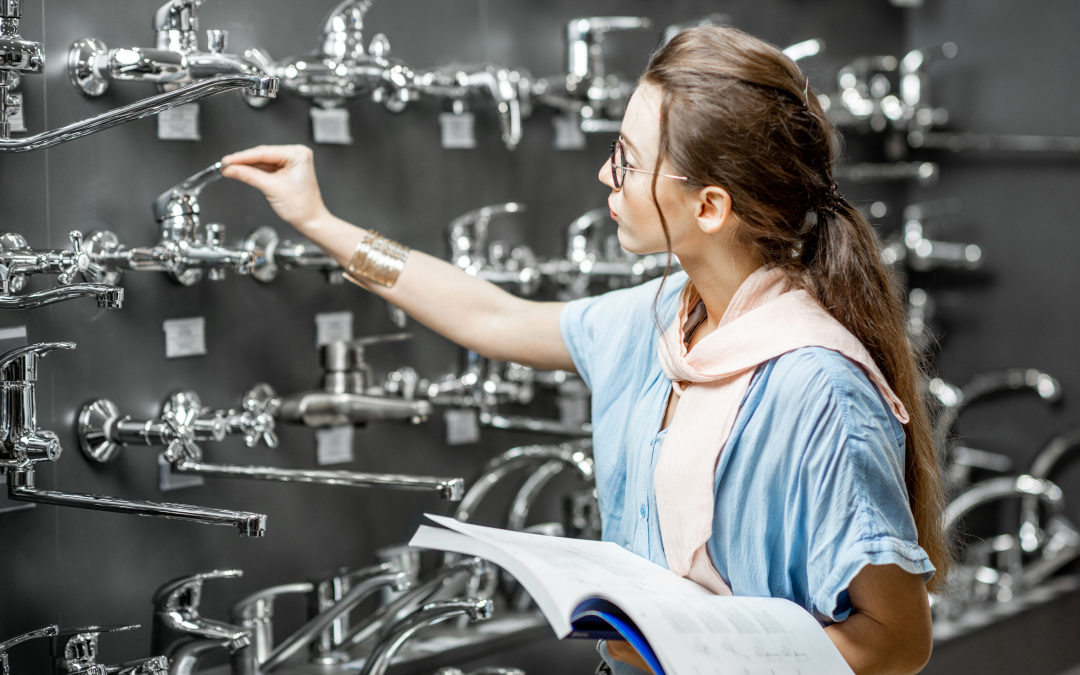When it comes time to remodel your bathroom, it’s important to consider what you want to upgrade. If you’re committed to replacing your shower, be it with a new showerhead or to convert it into a standing shower, you’ll need to consider your shower valve.
By understanding your shower valve, you can make the best decisions for your bathing preferences. With the right valve, you can change the temperature, water pressure, and even the type or number of showerheads.
We’ll walk you through what a shower valve is, the common types, and which are best for your situation.
What is a Shower Valve?
Many believe that the valve is the handle you use to control the temperature and flow of water. This isn’t entirely accurate.
The valve is the actual plumbing part behind the shower frame that controls the water temperature and pressure. The handles and escutcheon, or wall plate, cover the valve. During construction, the valve is “roughed” into place in the wall frame and wielded into the hot and cold water pipes.
When choosing your trim, you need to make sure your shower valve can receive the trim. Most trim kits require a specific model valve, usually from the same manufacturer. It’s possible to replace the valve, but this can require considerably more work from yourself or your plumber.
The 5 Types of Shower Valves
Mixing Valves
This is a traditional valve that is no longer used in construction. You usually only find these in older homes that haven’t been remodeled in a long time.
- Pros: Mixes hot and cold water, increasing your hot water supply.
- Cons: Cannot easily replace, cannot regulate water pressure, runs the risk of scalding you if someone draws cold water from another source.
Pressure Balancing Valves
These are the most common types of shower valves. They are designed to rebalance water pressure to keep the water from becoming too hot. Most have a single control handle that requires you to turn the valve left or right to adjust your water temperature and pressure.
- Pros: Inexpensive, very common, controls water temperature and water pressure easily
- Cons: Not accessible for everyone with its handle design, doesn’t offer any additional functionality if you want to upgrade in the future.
Thermostatic Valves
These valves are designed to more easily maintain both water pressure and temperature. They contain a thermosensitive element that adjusts the flow of hot or cold water based on changes in temp. Users can manually adjust a dial to set their ideal water temperature, allowing for consistent access to hot or cold water.
- Pros: Offers more control and consistency over your water temperature, can easily change the water temperature and water pressure.
- Cons: More expensive than other options, paying for what you’re getting.
Diverter Valves
Diverter valves are specifically designed to work with shower and tub combos. There are three types that vary based on how you want to access the tub and shower functions.
- Pros: Perfect for those who want a shower and a bathtub, different types allow for more choice.
- Cons: Only worth it if you plan to use both functions.
Transfer Valves
These valves allow for water to flow to multiple outlets, like a handheld showerhead or multiple shower heads on the wall or ceiling. extra shower heads in your shower.
- Pros: Allows for the most customization and elaborate set-ups in your shower. Perfect for making your shower more accessible and hands-free.
- Cons: Expensive and complex to set up. Also uses more water than the other valves.
Which Shower Valve is the Best?
In order to answer this question, you have to consider your specific situation. Not everyone wants a shower and bathtub combo, or a portable shower head. Here’s a breakdown of the valves and where they work best.
- Mixing Valves are not a great choice for upgrades, but you can work with them if you’re renovating on a budget
- Pressure Balancing Valves are your standard option for a basic shower. If you care more about how your whole bathroom looks, you probably want to invest in this relatively inexpensive option
- Thermostatic is a fancier option designed for those who want more control over their temperature and pressure, but without having to manually adjust. This choice is more of an investment, but you get what you pay for
- Diverter Valves are for those looking for a tub/shower combo, and it’s difficult to make this work without one.
- Transfer Valves are the top of the line, designed for either overly fancy and multi-function showers, or for accessibility to give multiple people your household options.
Picking the Right Person to Replace Your Shower Valve
Whatever type of shower you want, it all starts with the right shower valve. If you’re unsure of your options or need help installing/replacing your current shower, be sure to call Mike Wilson Plumbing.
Our staff has decades of experience in bathroom renovation projects and can help you professionally install your new bathroom. We work with homeowners throughout Richmond and Chesterfield, ensuring they have the best plumbing for their homes.
Contact us to schedule a consultation and see how Mike Wilson can help you create the best shower for your home.

